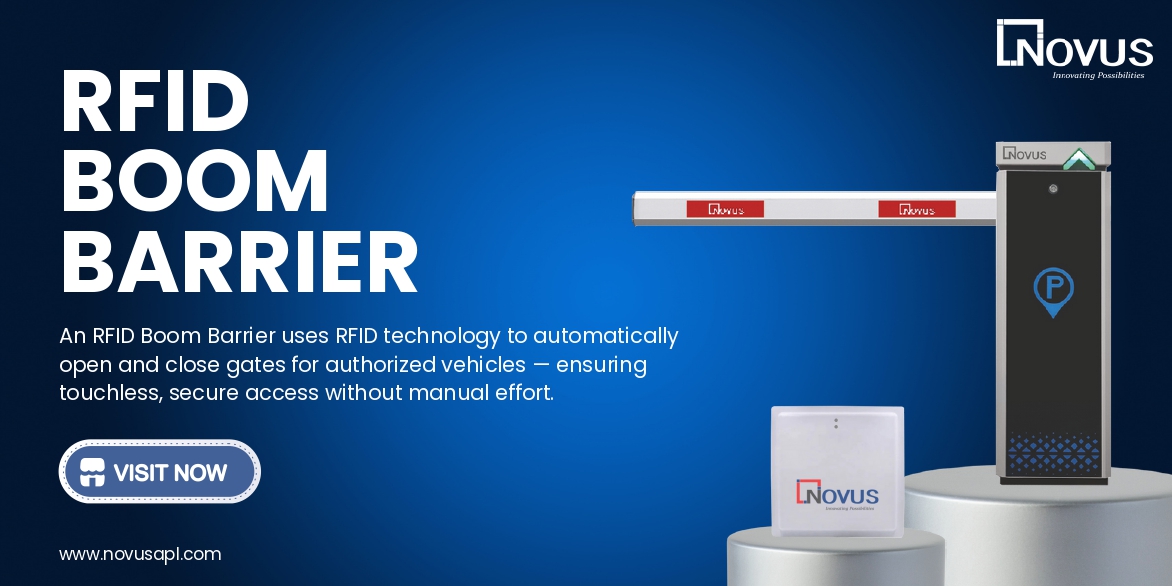
2) What Is an RFID Boom Barrier and How Does It Work?
3) What Exactly Is an RFID Boom Barrier?
4) How Does an RFID Boom Barrier Work?
6)Why Businesses Are Switching to RFID Boom Barriers
9)Challenges and How to Overcome Them
If you’ve ever driven into an office complex, gated community, or toll plaza and watched a barrier lift automatically without anyone pressing a button — you’ve just met an rfid boom barrier in action. These systems blend old-fashioned reliability with modern automation, offering seamless, contactless vehicle entry using RFID (Radio Frequency Identification) technology. In today’s world, where convenience and security go hand in hand, RFID boom barriers have become an essential part of efficient access control systems.
An rfid boom barrier is essentially a gate system that automatically opens when it detects a valid RFID tag — usually attached to a vehicle or carried by an authorized user. Instead of relying on a guard or manual ticketing, the system uses radio signals to recognize and grant entry to approved vehicles. Think of it as a smart handshake between your car and the gate — all done in milliseconds. According to Wikipedia, RFID technology allows wireless data transfer between a reader and a tag, making it perfect for identification and access control applications.
Let’s break down the process step by step:
Different tags serve different purposes, depending on range and usage:
Choosing the right tag depends on how fast vehicles move, how large the lane area is, and how many vehicles access the site daily.
Automation is no longer a luxury — it’s a necessity for operational efficiency and security. Here’s why organizations across industries prefer RFID boom barriers:
From IT parks to logistics yards — rfid boom barrier systems deliver smooth access management without human error.
You’ll find RFID boom barriers in a wide variety of environments:
Whether you manage a commercial building or a private gated society, RFID boom barriers make daily traffic flow simpler and more secure.
Installing an RFID-based system isn’t complicated — but a little planning goes a long way.
Even the best systems have their quirks. Here are a few common issues — and their fixes:
The cost of an rfid boom barrier setup varies depending on:
Generally, passive RFID systems are more budget-friendly, while active RFID systems cost more but handle larger, faster-moving areas. It’s always best to compare multiple suppliers and evaluate total cost of ownership (TCO) — not just the upfront price.
RFID systems are evolving fast. The future points toward smart integrations — like pairing RFID with ANPR (Automatic Number Plate Recognition), IoT monitoring, and cloud-based control dashboards.Soon, rfid boom barriers will communicate directly with mobile devices, enabling virtual tags and real-time analytics — creating a truly connected and intelligent access ecosystem.
Passive tags work within 1–3 meters, while active tags can reach up to 30–100 meters, depending on configuration.
Yes, most tags can be reprogrammed or reassigned when a vehicle changes ownership.
High-frequency or encrypted tags are very secure. Unauthorized duplication is rare when modern encryption is used.
Not significantly. Quality RFID readers and IP-rated tags are designed to withstand harsh outdoor conditions.
Absolutely. It can connect with ANPR, CCTV, attendance, and even mobile app systems for unified access control.
The system remains operational if connected to a UPS or solar-battery backup. Manual override options can also be used.
Usually 1–3 days per gate, depending on site complexity and integration needs.
Routine inspection, cleaning of readers, checking cables, and occasional software updates ensure reliability.
Yes. Temporary or disposable RFID tags can be issued for visitors and contractors.
RFID systems offer faster, more accurate, and contactless access control — reducing manpower while increasing efficiency and safety.
An rfid boom barrier is more than just a gate — it’s a smarter, faster, and safer way to control access. Whether you’re managing residential parking, industrial zones, or commercial buildings, RFID technology ensures secure, frictionless entry and peace of mind. At Novus Automation Pvt. Ltd., we help organizations embrace smarter access systems that blend innovation with reliability.
Accelerate Your Business with Novus Automation
Become a Partner